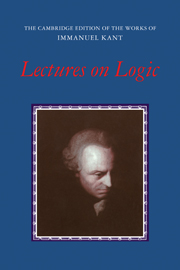Book contents
- Frontmatter
- Contents
- General editors' preface
- Acknowledgments
- Translator's introduction
- PART I The Blomberg logic
- Introduction to the doctrine of reason according to the thoughts of Professor Kant
- Introduction to the doctrine of reason according to the Author
- The doctrine of reason itself: The first principal part
- The doctrine of reason itself: The second principal part
- The doctrine of reason itself: The third principal part
- The doctrine of reason itself: The fourth principal part
- PART II
- PART III The Dohna-Wundlacken logic
- PART IV The Jäsche logic
- PART V Appendixes
- Explanatory notes
- Name index
- Subject index
The doctrine of reason itself: The first principal part
Published online by Cambridge University Press: 05 June 2012
- Frontmatter
- Contents
- General editors' preface
- Acknowledgments
- Translator's introduction
- PART I The Blomberg logic
- Introduction to the doctrine of reason according to the thoughts of Professor Kant
- Introduction to the doctrine of reason according to the Author
- The doctrine of reason itself: The first principal part
- The doctrine of reason itself: The second principal part
- The doctrine of reason itself: The third principal part
- The doctrine of reason itself: The fourth principal part
- PART II
- PART III The Dohna-Wundlacken logic
- PART IV The Jäsche logic
- PART V Appendixes
- Explanatory notes
- Name index
- Subject index
Summary
THE FIRST SECTION
Of learned cognition universally in general
In this paragraphus the author wanted to give a definition of representation, but because he could not do it he helped himself out with a rhetorical flight, as commonly happens when one can say nothing certain. He says at the end that a representation acts like a picture that shows the pictorial skill of the soul in its interior. What representation is cannot really be explained. It is one of the simple concepts that we necessarily must have. Every man knows immediately what representation is. Cognitions and representations are of the same sort. Concepts are somewhat different from them, however, as we shall see in what follows. Cognition and representation are taken in logic to be of the same sort. Every representation is something in us, which, however, is related to something else, which is the object. Certain things represent something, but we represent things. Logic does not teach us how we ought to represent something by means of consciousness, but rather it presupposes the consciousness of something as a psychological matter.
In every cognition whatsoever we find something material. But also something formal.
The object as we represent [it] is the material, while the manner of the representation is called the formal. If, e.g., I represent virtue to someone, then I can look in part to what I represent, in part to how I represent it[;] the latter is the formal[,] the former the material in the representation.
- Type
- Chapter
- Information
- Lectures on Logic , pp. 27 - 234Publisher: Cambridge University PressPrint publication year: 1992



